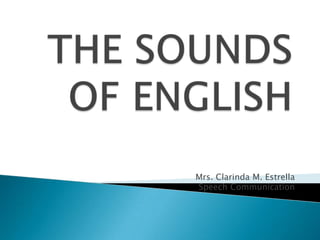
The Sounds of English Explained
- 1. THE SOUNDS OF ENGLISH Mrs. Clarinda M. Estrella Speech Communication
- 2. The sounds of General American English are classified into three namely: 1. Vowels (11) 2. Diphthongs (3) 3. Consonants (25)
- 3. THE ENGLISH VOWELS Vowels are sounds which are produced with the vibration of air in the oral cavity All vowel sounds are voiced oral sounds The relationship of the vowels to one another is shown by the device known as the Vietor Triangle
- 5. When a speaker enunciates a vowel, his or her air flow remains unblocked. This table, containing American English vowels, explains that the degree of elevation of a speaker’s tongue determines the sound of the spoken vowel.
- 6. VOWEL SOUNDS: 1. /iy/ - beat, me, key, seed, chief 2. /i/ - sit, give, rid, pick, live 3. /ey/ - ate, ray, face, weigh, great 4. /e/ - met, let, head, less, tell 5. /ae/ - cat, am, bag, land, class
- 7. 6. /a/ - pot, block, got, cop, lost 7. / / - ball, talk, saw, draw, dawn 8. /ow/ - hope, go, wrote, home, soak 9. /u/ - look, good, would, sure, bush 10. /uw/ - moon, blue, rule, chew, suit 11. /∂ / - luck, must, touch, gone, cup
- 8. VOWEL SOUND PRODUCTION TONGUE POSITION OR ADVANCEMENT – refers to the part of the tongue that is most active in the production of vowels. Vowels are described in relation to the highest point of the hump formed. TONGUE AND JAW HEIGHT – refers to the degree of closeness of the lower jaw to the upper or the tongue to the palate
- 9. 3. LIP POSITION – refers to the amount of rounding or spreading of the lips. a. rounded – when the corners are brought forward b. unrounded (spread) – when the corners are pulled back 4. TENSION – refers to the degree to which the muscles of the speech tract are tense or lax during sound production 5. LENGTH – refers to the duration (long or short) the vowel is held in a certain position
- 17. B. NATURE OR OBSTRUCTION OR MANNER OF ARTICULATION STOPS – are produced by stopping the passage of the breath stream with a build up of pressure behind the closure before releasing the breath vlvd Bilabial stops /p/ & /b/ Alveolar stops /t/ & /d/ Velar stops /k/ & /g/
- 18. 2. FRICATIVES – are continuants produced when the air stream is not completely stopped but passes through with friction or a hissing sound vlvd Labiodental fricatives /f/ & /v/ Dental fricatives /θ/ & /ð/ Alveolar fricatives /s/ & /z/ Post alveolar fricatives /r/ Palatal fricatives /∫/ & /dz/ Glottal fricatives /h/
- 19. 3. AFFRICATES – are produced when a stop combines with a fricative. Like fricatives, they are also continuants. They may be prolonged as long as the speaker wishes. Alveolar affricates /t∫/ & /dz/ 4. NASALS – are produced with the air stream passing through the nose rather than the mouth Bilabial nasal /m/ Alveolar nasal /n/ Velar nasal /ŋ/
- 20. 5. LATERAL – is produced when the air stream is stopped in the center by the tip of the tongue against the alveolar ridge, while the air passes along one or both sides of the tongue Alveolar lateral /l/ 6. SEMI-VOWELS – in their production, there is lack of friction and the sounds are vowel-like in their voicing but they function as consonants Bilabial /w/ - wear, win /wh/ - why Palatal /y/ - new, view
- 21. C. POINT OF ARTICULATION – refers to the upper parts of the mouth which the lowers parts (articulators) come in contact with the production of the consonant sound BILABIAL – when the lower lip touches the upper lip to produce the consonant sound * /p/, /b/, /m/ & /w/ 2. LABIO-DENTAL – when the lower lip comes in contact with the upper front teeth * /f/ & /v/
- 22. 3. DENTAL – when the lower teeth approach the upper teeth * /θ/ & /ð/ 4. ALVEOLAR – when the tip of the tongue is raised close to the toothridge or the back of the upper front teeth * /t/ & /d/ 5. POST ALVEOLAR – when the tip of the tongue is articulated against the back part of the alveolar ridge * /r/
- 23. 6. PALATAL – when the tongue is arched towards the hard palate * /∫/ 7. VELARS – when the back of the tongue closes against the velum or soft palate * /k/ 8. GLOTTAL – when friction is produced by the air passing through the glottis * /h/
